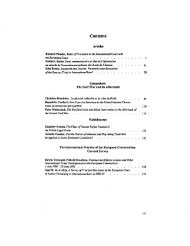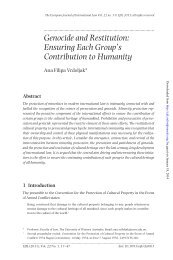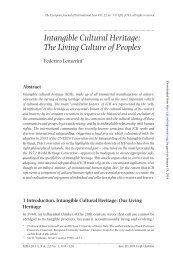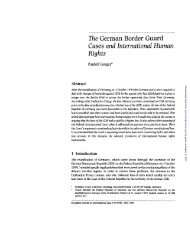Donatella della Porta and Manuela Caiani. Social Movements and ...
Donatella della Porta and Manuela Caiani. Social Movements and ...
Donatella della Porta and Manuela Caiani. Social Movements and ...
You also want an ePaper? Increase the reach of your titles
YUMPU automatically turns print PDFs into web optimized ePapers that Google loves.
Book Reviews 611<br />
Downloaded from http://ejil.oxfordjournals.org/ by guest on January 18, 2014<br />
<strong>Donatella</strong> <strong>della</strong> <strong>Porta</strong> <strong>and</strong> <strong>Manuela</strong> <strong>Caiani</strong>. <strong>Social</strong> <strong>Movements</strong> <strong>and</strong><br />
Europeanization. Oxford: Oxford University Press, 2009. Pp. 215. £44.00. ISBN:<br />
9780199557783.<br />
There is an ever-growing body of literature in law <strong>and</strong> political science on the illusive concept<br />
of Europeanization. A lot of the discussion in the literature attempts to define Europeanization<br />
<strong>and</strong>, on the basis of such a definition, to elaborate on the content of the concept. <strong>Donatella</strong> <strong>della</strong>
612 EJIL 22 (2011), 589–619<br />
<strong>Porta</strong> <strong>and</strong> <strong>Manuela</strong> <strong>Caiani</strong>, who both work in political science departments, contribute to this<br />
discussion by combining insights from the existing body of literature with new empirical findings<br />
in order to demonstrate the relevance of the European Union to social movements. The<br />
authors situate the discussion surrounding the involvement of social movements in the process<br />
of Europeanization within the aftermath of the failed referenda on the European Constitution in<br />
France <strong>and</strong> the Netherl<strong>and</strong>s in 2005 in order to illustrate the contribution of social movements<br />
to the debates on European integration. The authors refer to the literature in the area of social<br />
movement studies. 1 However, they also go beyond the field <strong>and</strong> combine insights from the literature<br />
on Europeanization with empirical research in order to address the involvement of social<br />
movements in the process of Europeanization. An example of such involvement is the Europeanwide<br />
campaign against the so-called ‘Bolkestein’ Directive in which social movements actively<br />
participated. <strong>Social</strong> movements, in this context, are defined as ‘dense informal networks of collective<br />
actors involved in conflictual relations with clearly identified opponents, who share a<br />
distinct collective identity, using mainly protests as their modus oper<strong>and</strong>i’. 2<br />
The introductory chapter of the book neatly summarizes <strong>and</strong> clarifies the broader academic<br />
debate on the nature of Europeanization. By looking at works by inter alia Risse, Green Cowles<br />
<strong>and</strong> Caporaso, 3 Borzel <strong>and</strong> Risse, 4 <strong>and</strong> Radaelli, 5 the authors conclude that ‘Europeanization<br />
involves a complex process of transcending internal boundaries, as well as constructing<br />
new boundaries against the outside’ (at 10). Europeanization is, therefore, ‘the product of<br />
the interaction of various actors’ (at 11). This suggests that Europeanization adds a layer<br />
of complexity to the sphere within which social movements act. <strong>Social</strong> movements can influence<br />
the European process of decision-making ‘from below’ by, for example, organizing<br />
protests at the national level with a view to influencing decisions at the European level.<br />
The additional layer of complexity which results from the European influence can offer social<br />
movements different outlets to voice their concerns. However, in order to benefit from<br />
such outlets, social movements must adapt their structures <strong>and</strong> actions to take account<br />
of the different levels of decision-making. In addition, the authors suggest that greater<br />
involvement of social movements at the European level could enhance the transparency <strong>and</strong><br />
public accountability of European governance.<br />
In order to clarify the complex picture of social movement involvement in Europeanization,<br />
the authors use triangulated sources <strong>and</strong> methods: ‘claim analysis, based upon the mass-media<br />
coverage of Europe; semi-structured interviews with representatives of different collective<br />
actors; <strong>and</strong> surveys of demonstrators at protest events addressing the EU’ (at 27). The data used<br />
cover supranational actors at the EU level <strong>and</strong> national actors in Germany, Spain, France, Italy,<br />
Downloaded from http://ejil.oxfordjournals.org/ by guest on January 18, 2014<br />
1<br />
They refer to works by inter alia C. Tilly (From Mobilization <strong>and</strong> Revolution, Addison-Wesley, Reading, MA,<br />
1987; <strong>Social</strong> <strong>Movements</strong>, 1768–2004, Paradigm, Boulder, CO, 2004), S. Tarrow (Power in Movement:<br />
<strong>Social</strong> <strong>Movements</strong>, Collective Action <strong>and</strong> Politics, CUP, New York, 1994), H. Kriesi et al. (New <strong>Social</strong> <strong>Movements</strong><br />
in Western Europe: A Comparative Analysis, University of Minnesota Press, Minneapolis, 1995),<br />
<strong>and</strong> D. <strong>della</strong> <strong>Porta</strong> <strong>and</strong> D. Rucht (‘Left Libertarian <strong>Movements</strong> in Context: Comparing Italy <strong>and</strong> West<br />
Germany, 1965–1990’ in J. Craig Jenkins <strong>and</strong> B. Kl<strong>and</strong>ermans (eds.), The Politics of <strong>Social</strong> Protest, University<br />
of Minnesota Press, Minneapolis, 1995).<br />
2<br />
At p. 6. The definition is borrowed from D. <strong>della</strong> <strong>Porta</strong> <strong>and</strong> M. Diani, <strong>Social</strong> <strong>Movements</strong>: An Introduction,<br />
Malden, MA: Blackwell, 2006.<br />
3<br />
T. Risse, M. Green Cowles <strong>and</strong> J. Caporaso (eds), Transforming Europe: Europeanisation <strong>and</strong> Domestic<br />
Change, Cornell, Ithaca, NY, 2001.<br />
4<br />
T.A. Borzel <strong>and</strong> T. Risse, ‘When Europe Hits Home: Europeanization <strong>and</strong> Domestic Change’ (2000) European<br />
Integration Online Papers 4/15.<br />
5<br />
C. Radaelli, ‘Whither Europeanisation? Concept Stretching <strong>and</strong> Substantive Change’ (2000) European<br />
Integration Online Papers 4/8.
Book Reviews 613<br />
the Netherl<strong>and</strong>s, the United Kingdom, <strong>and</strong> Switzerl<strong>and</strong>. By studying empirical data on social<br />
movements from a number of different countries against the background of the concept of Europeanization<br />
this book is not only interesting for academics, but may also be helpful for social<br />
movements in shedding light on how they could use the process of Europeanization for their<br />
benefit. An added advantage of examining the data of multiple countries is that they illustrate a<br />
whole range of opportunities that social movements may be able to exploit.<br />
Following the introduction, the next two chapters of the book systematically break down the<br />
involvement of social movements in the process of Europeanization with a view to clarifying<br />
‘the ways in which both “domesticated” <strong>and</strong> “externalized” protests carry the potential to generate<br />
European social movements – leading to social mobilization <strong>and</strong> a nascent public sphere –<br />
which, in turn holds the potential to increase the EU’s democratic quality’ (at 34). 6 These two<br />
chapters begin with practical examples which illustrate the meaning of domestication <strong>and</strong> externalization<br />
of social movement protest. Thus, the campaign of Italian dairy farmers against<br />
fines imposed for the violation of EU milk quotas in 1997 is used to introduce the concept of<br />
domesticated protest, <strong>and</strong> the European-wide campaign against the so-called ‘Bolkestein’ Directive<br />
illustrates the externalization of social movement protest. The use of practical examples<br />
helps to elucidate the subsequent discussion in each of the two chapters on the influence of Europeanization<br />
on social movements. A final chapter before the conclusion focuses on the supranational<br />
level by examining the emergence of Europe-wide social movements.<br />
The authors draw interesting conclusions from their research. The empirical data point towards<br />
a ‘slowly emerging Europeanization from below, which predominantly takes the path<br />
of “domestication” . . . Domestication might be seen as proof of the persistent relevance of the<br />
nation-state as the target for protest, as well as the permanent weakness of the EU institutions’<br />
(at 81). The main focus of social movement action seems to remain predominantly the national<br />
level. Protests still largely centre on national issues <strong>and</strong> occur within a particular nation-state.<br />
This finding, whilst interesting, is not necessarily surprising. <strong>Social</strong> movements such as trade<br />
unions (which are frequently cited in this book) have been operating at a national level for a<br />
very long time <strong>and</strong> have established functioning structures <strong>and</strong> mechanisms to make their<br />
voices heard. The increasing relevance of the European level through the process of Europeanization<br />
requires these national actors to reorientate their policies <strong>and</strong> modes of action – a process<br />
which is obviously difficult for any institution. In the case of trade unions, the increasing<br />
influence of the European level comes at a time when they are already struggling to adapt to<br />
changing regulatory <strong>and</strong> opportunity structures at a national level. An inability to adapt to the<br />
effects of Europeanization could therefore further weaken trade unions at the national level.<br />
What is particularly heartening is that the authors, in their chapter on the ‘Externalization<br />
of Protest’, find ‘clear signs of an adaptation to multilevel governance, especially in terms of a<br />
growing targeting of EU institutions, framing issues as EU-related, <strong>and</strong> transnational networking<br />
of domestic organizations’ (at 125). The increasing transnationalization of social movements<br />
is also confirmed in the final chapter, where the authors examine the supranational level.<br />
The authors conclude that there is increasing evidence pointing towards the emergence of an innovative,<br />
transnational European social movement. Obviously, the scope for social movements<br />
to act at the European level is more limited than at the national level. In particular, there is less<br />
scope for direct mobilization of protest. Nonetheless, use of the European level <strong>and</strong> the European<br />
institutions could support <strong>and</strong> strengthen action taken at the national level. A successful Europeanization<br />
could therefore help social movements to achieve their aims.<br />
Downloaded from http://ejil.oxfordjournals.org/ by guest on January 18, 2014<br />
6<br />
‘Domesticated’ protests are those protests that take place at a national level <strong>and</strong> are oriented to change<br />
decisions at the European level. ‘Externalized’ protests use the European level as an arena for mobilization<br />
with a view to modifying national policies.
614 EJIL 22 (2011), 589–619<br />
Overall, this book offers a very clear <strong>and</strong> succinct analysis of the relationship between the process<br />
of Europeanization <strong>and</strong> social movements. As the influence of the European Union on the<br />
national level grows, social movements are beginning to Europeanize their structures in order to<br />
target EU institutions. The increasing competences of the EU thus lead to a growing recognition<br />
on the part of social movements of similarities of national causes <strong>and</strong> the usefulness of targeting<br />
EU institutions in order to achieve these causes. While ‘the closure of political opportunities at<br />
the EU level . . . [<strong>and</strong>] the material costs of mobilizing transnationally . . . can all contribute to low<br />
levels of protest organized in Brussels or by European social movement organizations’, there are<br />
signs that ‘paths of Europeanization of social movements do exist <strong>and</strong> are indeed increasingly<br />
visible’ (at 169). In their conclusions, the authors call for future research to examine the potential<br />
role of civil society in a supranational democracy following European enlargement, taking<br />
into account trends in Eastern Europe.<br />
The clarity of the analysis makes the book accessible to those who are not experts in the field.<br />
The book demonstrates that social movements have very diverse attitudes to Europe, <strong>and</strong> it<br />
would be especially interesting if the attitudes of specific movements or particular strategies were<br />
to be examined in more detail in a comparative manner. In addition, suggestions could be made<br />
as to how social movements could act at the European level more effectively. Such suggestions<br />
are, however, beyond the scope of this book. From a legal perspective the findings of the book<br />
raise interesting questions about the extent to which social movements use law in achieving<br />
their aims both at the national <strong>and</strong> the European level. Particularly following the entry into force<br />
of the Lisbon Treaty, social movements have access to multiple legal strategies in order to make<br />
their voice heard at a European level. By way of example, the Treaty’s emphasis on dialogue with<br />
civil society opens up new ways for social movements to become involved in EU policy-making.<br />
Specifically, the citizens’ initiative enables individuals <strong>and</strong> social movements to lobby the European<br />
Commission to initiate legislation on a specific measure. Moreover, increased <strong>and</strong> easier<br />
access to the European Court of Justice enables social movements to bring actions challenging<br />
European acts. All acts of the European Union must comply with the principles enshrined in the<br />
Charter of Fundamental Rights <strong>and</strong> the Lisbon Treaty. Any act that does not is open to challenge<br />
before the European Court of Justice. Arguments brought by social movements before the European<br />
Court of Justice will benefit from being based upon provisions of the Charter of Fundamental<br />
Rights. These legal options available to social movements are not dealt with extensively in the<br />
book under review. However, it would be interesting to examine to what extent social movements<br />
use, for example, the newly created citizens’ initiative or the increased <strong>and</strong> easier access to<br />
the European Court of Justice in their attempts to europeanize. <strong>Social</strong> <strong>Movements</strong> <strong>and</strong> Europeanization<br />
provides a firm platform from which such future research projects can be launched.<br />
Rebecca L. Zahn, Dr. jur.,<br />
Max Weber Fellow, European University Institute<br />
Email: Rebecca.Zahn@eui.eu<br />
doi: 10.1093/ejil/chr036<br />
Downloaded from http://ejil.oxfordjournals.org/ by guest on January 18, 2014








